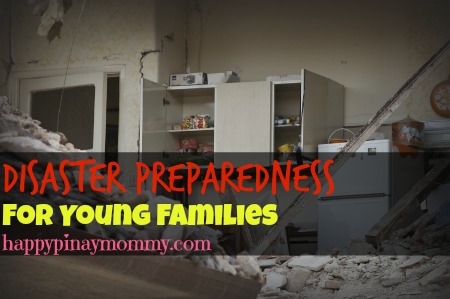
“The Big One” or the high intensity earthquake that is supposed to hit Manila and nearby provinces continues to generate buzz over social media. And although, Phivolcs has already denied issuing any warning about an exact range of time when this earthquake could take place, it said that it is still best to be prepared.
For us moms with young children, a strong earthquake gets all the more scary because we do have little ones to think of. How can we ensure their safety, how do we ensure that they will have enough to eat, and that they will still have clothes on their backs until we get help?
In my opinion, the best thing that we can do to prepare our families for disaster are the following –
General tips on Disaster Preparedness for Young Families:
- Have a family plan. even if it is just you and your husband and the kids, make sure that your husband will know where to find you guys and vice versa in case he is at work, or you are at work when an earthquake takes place and there would be a need to evacuate.
- Set aside a budget for disaster preparedness. The disaster kits, go bags, extra provisions in the car and in the pantry, emergency cash, plus some gadgets definitely do not come cheap. Set aside a budget for family disaster preparedness so that these supplies will remain intact.
- Practice. If you have school-aged children, it is best to make your children aware of what to do in case there is an earthquake especially if it happens while they are in school. Talk to their teacher and ask if they have emergency plans in place and if they have earthquake drills in school. Assure your school-aged child as well that you or someone from your family will come for her in case she gets stuck somewhere in school.
(Post Continued Below)
=====================================================================
You may also want to read:
- What to pack in a Go Bag for Babies
- Emergency Go Bag Contents for Toddlers
- Where to buy Insulated Breast Milk Cooler Bags in the Philippines
- Where to buy Ring Slings in the Philippines
- Where to buy Tula Baby Carriers
- Filipino Preserved Food Recipes
- Where to buy Tawa-Tawa for Dengue in the Philippines
- Where to Buy Affordable Nebulizers in the Philippines
=====================================================================
- Invest in tags. Some parents make their children wear bracelets with their mobile number for emergency. For evacuation and emergency purposes, I think it will be best to have children wear an info bracelet or a dog-tag like necklace that contains the child’s name, your name, your contact information, blood type, and allergies if any.
- Harness technology. There are GPS watches for kids that can be very helpful during crisis situations (like this). Some do not even cost more than Php1500.00 and if you ask me, this will be totally worth it if you have a school aged child. There are also solar powered chargers in the market today that can be used as flash lights, and charging port for your electronic devices (check out this solar powerbank).
- Pack your go bag. The main items in the go bag should be care of mom and dad, and the older kids should have some for themselves too (yes, even your preschooler). Light snacks, medicines, flashlights and other light items can be placed in their bag to maximize the family’s main bug out bag. (Here’s a link to my post on what a go bag should contain especially for families with babies and young children). Of course the go bag itself has to be durable and easy to carry (like this). Also, revisit its contents every six months for those that are about to expire. Make sure as well that you are can carry the weight of your bag. An over-packed bag may hinder your chances of safely surviving a disaster.
- Stock your car with essentials too. This will be especially helpful if the big one occurs while you guys are on the road. Simple snacks, change of clothes, and other bug out / emergency items can be in a duffel bag in the trunk. Also, make sure your car has enough gas all the time, has a reserve tire, and all the necessary tools, plus extras like cables and portable air compressors for inflating your tires (like this).
- Your house should have some stock food and water too. This will be very helpful in case you are just at home, you do not need to evacuate BUT all the food and supplies stores have already closed shop. Make sure you have stock food that will not need refrigeration that could last you up to a week. Same goes with toiletries. Order extra water containers if you need to.
- Make sure you have cash too. In this cashless age, cash still remains king especially during emergencies. Have cash handy at your home in case you would need to evacuate.
- Send a softcopy of all your valuable docs and files in a secure email. In case the documents that you have gets lost, then these soft copies will all come in handy. same goes with your photos, create a back up, store in an external drive (this one is shock proof) and bring it with you in your bug out bag — or store it in the cloud or any secure online storage.
- Knowledge will always translate to power. Familiarize yourself with maps, where the fault line is, where the safe places are, and where you can evacuate safely. A compass could help to so orient yourself on how to use one. Follow the social media accounts of Phivolcs (here’s their FB Link), NDRRMC (Here’s the social media page link), your local DRRMC, PAGASA, Meralco (or your electricity provider), MMDA (if you are in NCR), The Red Cross (here’s their FB Link), as well as that of your local government and your trusted news agency.
- Relearn how to function without technology or high tech gadgets. That non-smartphone bar phone whose batteries can last for two days, has a flashlight and FM radio can save you and your family. Get one if you have already disposed yours (here’s one that is also waterproof!). Get a candle because your flashlight will soon lose batteries. Have a transistor radio with you if possible as well. Do not forget to bring in fans or abaniko too, especially since your young ones will need it. Have a hardcopy of important phone numbers and addresses of emergency contacts, family, and friends. Have a transistor radio at hand (here’s one that is under P500.00).
- Invest in a recommended baby or toddler carrier. Have this by your door or next to your emergency kit because this can literally be a lifesaver. Even if your toddler already knows how to walk, she may not be able to do it quickly. Ring slings are the most affordable and are very light and easy to pack, Soft Structured Carriers on the other hand are very helpful and reliable when it comes to emergency situations. Let baby wearing help you. Check out our section on babywearing to help you choose the right carrier for your family.
- Keep medical needs in mind. If you have an asthmatic child, you may need to have a portable nebulizer. Also have enough medicines in the house and in the go bag especially for maintenance meds and allergies.
- Be conscious of special needs within the family. If you are pregnant, know what to do as well to keep you and your unborn baby safe. Same goes if you live with elderly, or someone who is sick. Have enough of their supplies, and have a plan on how to evacuate them.
- Don’t forget about your pets. Extra food, and leash are the important things they will need. Make sure they are with you when you evacuate.
- Do not discount self-defense. Preppers cannot emphasize enough that it is very possible to meet someone willing to commit a crime in order to survive dire situations. Do not get caught flat-footed. Get at least a pepper spray for your family (get one here).
- Physically prepare for it. Exercise. Make yourself healthy. Your kids will be relying on you to get to safety and the greater your endurance, the higher the possibility of surviving a major disaster.
- Pray and rest your anxious heart. If and when you have prepped everything but when the actual disaster takes place and you can’t seem to carry your bug out bag, know in your mind that your family’s safety is the most important, and that we cannot bring any of these earthly possessions in the after-life.
Disaster preparedness should never be mistaken for paranaoia. Do not be affected with those that say you are over reacting to the news. Even if it is not an earthquake — fires, and urban flooding remain to be a threat that may require evacuation. At the same breath, hold off re-sharing alarmist social media posts from unverified sources. It will just be best to stay prepared all the time.
Yes, disaster kits as well as extra supplies, plus your time preparing these require time and money, but it will always be worth it. Choose to have peace of mind.
So there you have it, I will be updating this post as soon as I come across with more information on disaster preparedness for young families. Please drop by my facebook page for feedbacks, comments or suggestions.
Looking forward to hearing from you.
A Happy Homemaker is a Happy Pinay Mommy!
Leaving you with this video clip on making a family emergency plan:
http://happypinaymommy.com/2017/02/18/happypinaymommy-reflections-zachas-smileversary/
*This post contains affiliate links, at no extra cost to you. Thank you for supporting happypinaymommy.com*
